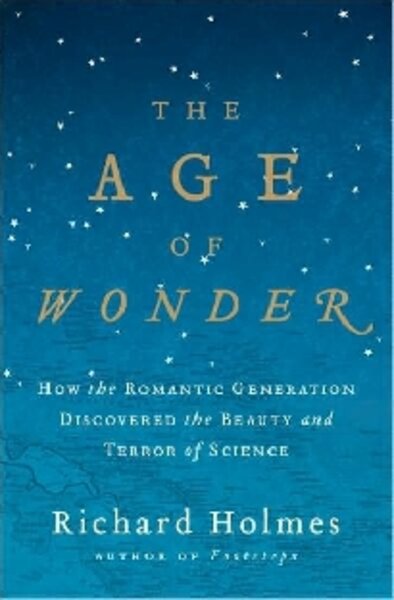The Age of Wonder
Loading...
In a time when a word as shaggy as “romantic” has been denuded of its rich and contradictory foliage of significance, it may be difficult for readers to appreciate the ironies at work in The Age of Wonder, Richard Holmes’s history of science and culture in the early 19th century.
For many in our mechanistic and technologized age, the word refers to nothing more than the passions of sexual attraction. It’s a telling fate for a word whose early exponents – such as Shelley, Wordsworth, and Coleridge – raged against the mechanical, rationalistic disenchantment of the world and the word.
To be sure, the Romantics were deeply troubled by the replacement of the ancient, the rank, and the mysterious with the new, the clean, and the rigorously explained. Not only poets, but painters, composers, and creators of all stripes began to oppose the implacable advance of the Enlightenment “philosophers” (the word “scientist” would not be coined until 1833, Holmes points out), who Keats famously warned would “clip an Angel’s wings” and “unweave [the] rainbow.” Wordsworth perhaps hymned the Romantic fears most pointedly, however, arguing (in “The Tables Turned”) that “our meddling intellect/ Misshapes the beauteous forms of things; —/ We murder to dissect.”
But Richard Holmes paints a different picture of the Romantic Age, one in which scientific discovery and artistic creation shared close company. Caught between the heady, gregarious early days of modern science and the buttondown, professionalized world of the late-19th century laboratory, the proto-scientists of the Romantic Age worked much like their poetical counterparts: largely alone, in the half-light, following inspiration and fancy as much as evidence and hypothesis. And the poets, despite the fear and disdain they expressed, were in fact besotted with science almost to a man. Natural and anthropological discoveries from far-flung foreign outposts inspired their verse; the vast distances and strange new worlds of the starry sky boggled their brains; the vantage points offered by both aeronauts in balloons and miners in the deep caverns offered perspectives on the planet which alloyed ancient stirrings with startling insights.
“The Age of Wonder” is as sprawling as it is dazzling. Holmes begins with Joseph Banks, who towered over the English scientific establishment in the 19th century. Wealthy and charismatic, Banks was a botanist, libertine, and scientific impresario (three words rarely associated, which together tell you something about Romantic science) who voyaged to Tahiti with Captain Cook, helped to usher in natural history’s golden age, and inspired a “botanizing” rage among both the scientifically and the poetically inclined of the English upper middle classes.
Holmes’s book is populated by a diverse number of similarly lively characters, including William and Caroline Herschel, siblings whose rigor and zeal transformed observational astronomy; Humphry Davy, autodidact chemist and inventor of the mining lamp; mathematician Charles Babbage, who all but invented the computer more than a century before the advent of the microprocessor; polymathic poet and physician Erasmus Darwin, whose spirit inspired his grandson to follow nature wherever it took him.
Holmes hardly stints on the poets, either, charting the work and opinions of Wordsworth, Southey, Shelley, Schelling, and Coleridge – who vowed to “attack Chemistry like a shark,” and whose verse is filled with stellar imagery that is a legacy of its author’s fascination with the Herschels’ discoveries.
And not least he includes Mary Shelley, who imbued the pursuit of scientific discovery with the dark rhythms of Germanic folk tales in her strange, great, much-misunderstood masterpiece, “Frankenstein.” In her protagonist Shelley showed that the Promethean ambitions of the scientist and the Orphic inspiration of the artist were twin passions. All but ignored alongside her well-known husband and the dazzling Byron, Mary Shelley captured the spirit and terror of Romantic science perhaps better than any author by inventing the genre we now call science fiction.
Holmes pursues his many-chambered nautilus of a tale with energy and great rigor, unearthing many lives and assembling remnant shards of biography, history, science, and literary criticism. It shouldn’t surprise anyone that there are gaps in his fossil record. “The Age of Wonder” is frank in its Anglocentrism; the near-absence of such a towering figure as Johann Wolfgang von Goethe is particularly puzzling; Holmes’s otherwise terrifically helpful “cast list” archly and bizarrely describes the poet as a “German heavyweight boxer” who “went ten rounds with the ghost of Sir Isaac Newton.” Similarly conspicuous is the invisibility of the American transcendentalists, whose engagement with science helped to spur a literary renaissance on this side of the Atlantic.
Such quibbles notwithstanding, “The Age of Wonder” will be rightly regarded as a magisterial treatment of an era which, in Holmes’s words, “contained terror as well as wonder... [and] brought new dread as well as new hope into the world.” As Holmes observes, it is this ironic predicament, as much as poetry, planets, and paradigms, which constitutes our Romantic inheritance.
Matthew Battles is a freelance writer in Jamaica Plain, Mass.






